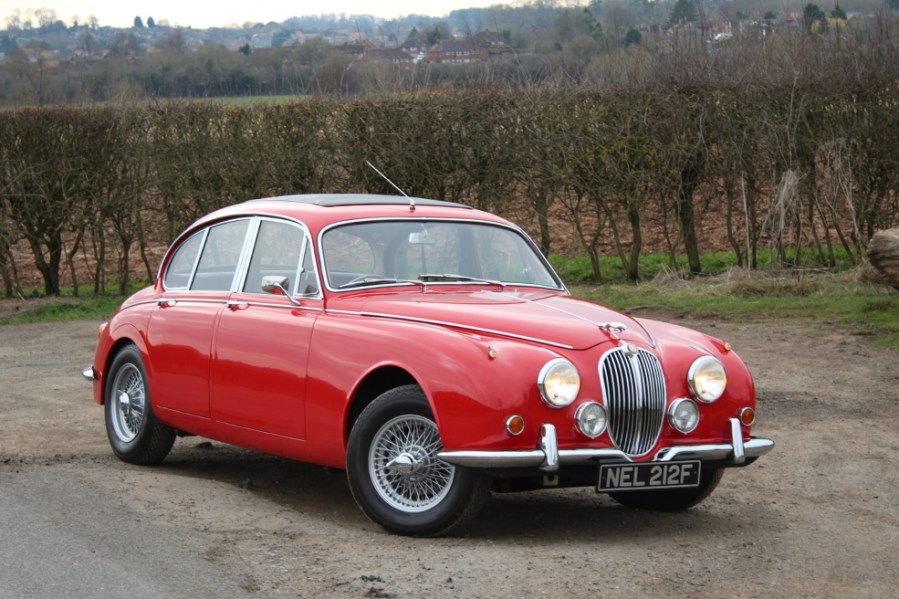This thoughtfully upgraded 1968 Jaguar Mk2 380 treads a careful line between modification and modernisation with great results
Words and images: Jack Grover With thanks to: Sherwood Restorations
Officially there is no such thing as a ‘Jaguar 380’, leaving the boot badge worn by this car a work of fiction. There were 3.8-litre Jaguar Mk2s of course – right from the start of production in 1959. This was essentially the same engine as found in the early E-types, but with the more restrictive head and manifolds as on the 3.4-litre engine and only two carburettors in deference to the Mk2’s restrictive engine bay.
In 1967 the Mk2 range was rationalised, with the 3.8-litre engine dropped and the remaining models renamed the 240 and 340. These lost their broad chrome bumpers and leather interiors in return for slim versions and plastic imitation material respectively. But despite some small mechanical improvements, such as variable-ratio power steering and a more modern automatic transmission on the 340, there was nothing akin to the upgrades found on this car.
Modification and modernisation can be touchy subjects in the classic car world – on the one hand it seems rather recursive to turn an old car into an inferior imitation of a modern one and diminish its historic nature. On the other, there is huge scope to gain reliability, durability and ease of use before the result negatively affects the nature of the car, without even considering improvements to performance.
This Jaguar treads the line between modification and modernisation very well. Initially, it appears as a Carmen Red Mk2 with chrome bumpers, wire wheels and lots of wood – far from unusual. But the specification list tells a different story. For starters the 3.8-litre engine wasn’t available in the Mk2 in 1968 – this one came from a MkX. It has also gained high-compression pistons, an XJ-style twin-carb manifold, electronic ignition, a high-speed starter motor and an alternator. Behind it sits a Tremec five-speed manual gearbox, and further back a rebuilt limited-slip differential and a Mk2 3.8-spec final drive.
That axle is restrained by four trailing links and a Panhard rod, while the front suspension features Harvey Bailey front springs and an anti-roll bar as well as GAZ adjustable dampers. All the suspension bushes are polyurethane. The steering is electrically assisted and a sharper ratio than standard. The rear wheels are custom and carry wider tyres. The Mk2’s famous four-wheel disc brakes are now vented and cross-drilled, with four-pot aluminium callipers on the front. In short, every significant part of this Mk2 has been upgraded, on top of a high-quality structural and cosmetic restoration.
Speaking of which – would you judge from the pictures that this Mk2’s paintwork is over 20 years old? And yet, there’s not a single scratch, imperfection, or patch of bubbling. The doors open and shut with lightness and precision, while the panel fit is as good as a Mk2 could reasonably be expected to be. The Webasto sunroof is a welcome addition for summer, too.
The inside is just as pleasing as the outside. There are dark red leather bucket seats in the front, which are from an XK140 – the original bench-type ones are with the car and can be refitted – while the power steering means a smaller Moto-Lita steering wheel can be utilised. There is some slight ‘pruning’ of the lacquer on the wood around the glove box lid but it’s still lustrous and the wood itself is in excellent condition.
It certainly doesn’t look as heavily upgraded as it is under the bonnet, with the familiar dull stainless cam covers evident. The firewall and inner wings are in superb condition, and this is not for the usual Jaguar reason of oil leaks – there are none. The wiring loom looks neat and fresh, too.
When cold it required a bit of churning on the high-torque starter to wake up that big straight six, but then it ran very smoothly. The Tremec gearbox shifts easily, with a smoothness far better than a period ‘box could. When warm it pulls with an almost fuel-injected level of response and smoothness, and delivers both thrilling levels of acceleration and a glorious mix of induction and exhaust noise.
There’s a noticeable improvement in stability too; with a real sense of sure-footedness. It’s more akin to the S-type with its independent rear end, and though the secondary ride quality isn’t as good, this Mk2 coves tree-root-distorted country roads with ease.
Jaguar Mk2 380: our verdict
This is not a ‘resto-mod’ with a modern drivetrain, engine management and a custom interior, leaving only the aesthetics of the past behind. Everything done to this Mk2 is entirely in keeping with the spirit of the breed – it still has a carb-fed XK engine, a direct-shifting manual gearbox and a live rear axle on quarter-elliptic springs. But it has been done to a high standard and with a high level of thought, so the result is a car that’s still very much a Mk2 but one which can be enjoyed in a way that a wholly original example probably could not in the 2020s.

















